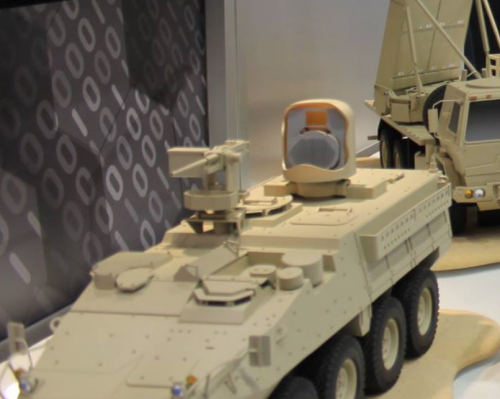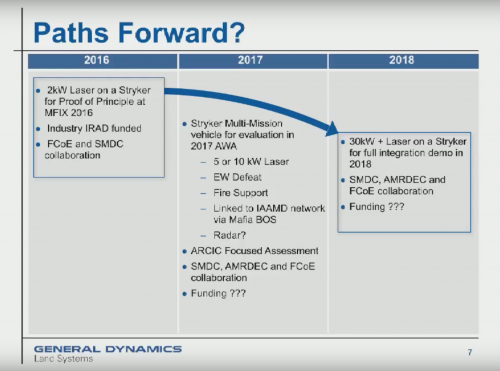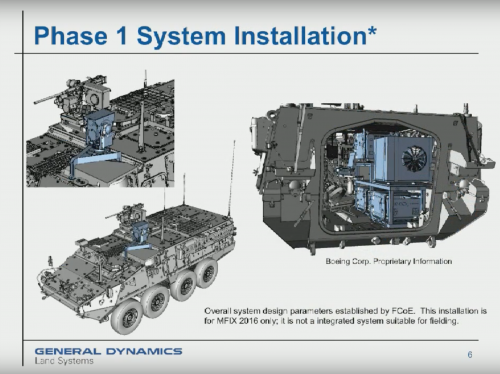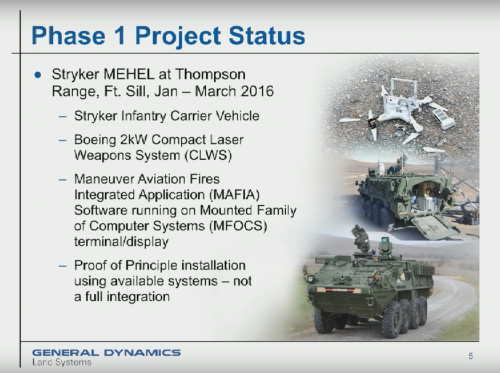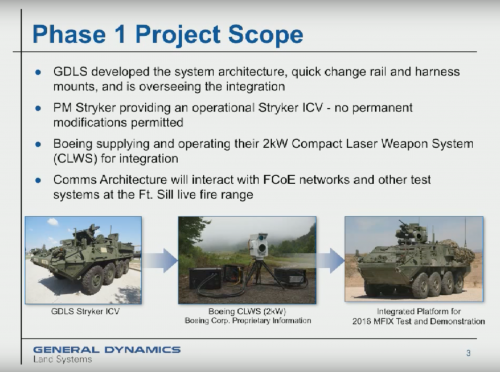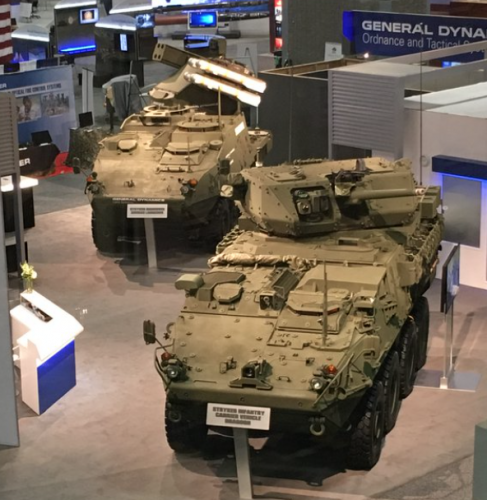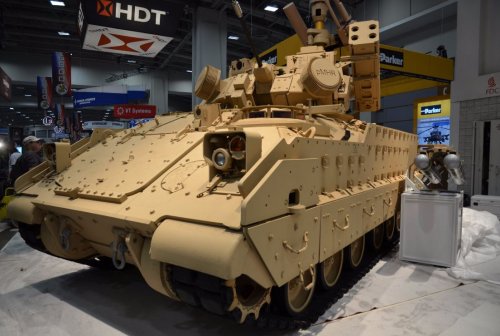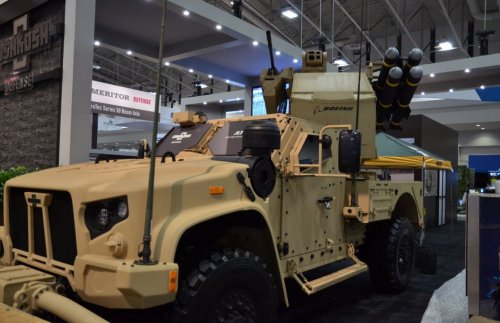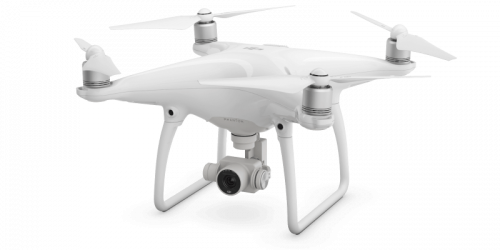You are using an out of date browser. It may not display this or other websites correctly.
You should upgrade or use an alternative browser.
You should upgrade or use an alternative browser.
Army Indirect Fire Protection System and New Guided Missile Program
- Joined
- 3 June 2011
- Messages
- 18,324
- Reaction score
- 12,183
bring_it_on said:
https://www.scribd.com/document/355679559/Industry-Day-2017-Briefings
This, while better than nothing at all, is just sad. I've said for years (hell, decades at this point) we should have used Pershing IIs in the antiship role. Oh well, at least China appears to have got it right (in theory anyway). Between all their various types of ballistic missiles, they can hit anything out to about 2500 miles from their coast with precision conventional or nuclear warheads within minutes - TODAY.
- Joined
- 21 April 2009
- Messages
- 13,739
- Reaction score
- 7,650
The C4 would have been a great solution IMHOsferrin said:bring_it_on said:
https://www.scribd.com/document/355679559/Industry-Day-2017-Briefings
This, while better than nothing at all, is just sad. I've said for years (hell, decades at this point) we should have used Pershing IIs in the antiship role. Oh well, at least China appears to have got it right (in theory anyway). Between all their various types of ballistic missiles, they can hit anything out to about 2500 miles from their coast with precision conventional or nuclear warheads within minutes - TODAY.
- Joined
- 3 June 2011
- Messages
- 18,324
- Reaction score
- 12,183
bobbymike said:The C4 would have been a great solution IMHO
C4? As in the Trident C-4? As an antiship missile? ???
- Joined
- 21 April 2009
- Messages
- 13,739
- Reaction score
- 7,650
If the Chinese have an anti ship IRBM.sferrin said:bobbymike said:The C4 would have been a great solution IMHO
C4? As in the Trident C-4? As an antiship missile? ???
- Joined
- 3 June 2011
- Messages
- 18,324
- Reaction score
- 12,183
bobbymike said:If the Chinese have an anti ship IRBM.sferrin said:bobbymike said:The C4 would have been a great solution IMHO
C4? As in the Trident C-4? As an antiship missile? ???
Even Pershing II would outclass everything except their new DF-26. (And probably that as well.)
Kat Tsun
eeeeeeeeeeeeeee
- Joined
- 16 June 2013
- Messages
- 1,368
- Reaction score
- 1,776
sferrin said:Never understood why Western systems just stick those expensive missiles right out there where they can get beat to crap and weathered. How about some canisters guys?
Canisters are not uncommon. Pretty much every Western system barring MIM-72 and Rapier has them. The Soviets had more exposed missiles than the West and they did fine with them.
- Joined
- 3 June 2011
- Messages
- 18,324
- Reaction score
- 12,183
Kat Tsun said:sferrin said:Never understood why Western systems just stick those expensive missiles right out there where they can get beat to crap and weathered. How about some canisters guys?
Canisters are not uncommon. Pretty much every Western system barring MIM-72 and Rapier has them. The Soviets had more exposed missiles than the West and they did fine with them.
Just thinking of Hawk, SLAMRAAM, MIM-72.
- Joined
- 26 January 2011
- Messages
- 2,226
- Reaction score
- 641
Different times, different means of guidance. Non-canister contained SAMs usually required exposure of the nose to allow it to acquire reflected radar signals from the intended target. Initially, this took up to a few seconds because of the use of valve and then later transistorised components in the guidance system. Also allowed easier heat shedding. With the creation of chip based guidance systems, acquisition times were reduced and the amount of heat produced decreased markedly. The west were quick to introduce those systems whereas the Russians were slower.
Then, with IR systems, you need the nose exposed to allow the guidance system to search the sky for it's target. With the introduction of chips, acquisition times were reduced and the ability to slave the guidance system were now possible, so the nose could be covered.
Then, with IR systems, you need the nose exposed to allow the guidance system to search the sky for it's target. With the introduction of chips, acquisition times were reduced and the ability to slave the guidance system were now possible, so the nose could be covered.
bring_it_on
I really should change my personal text
- Joined
- 4 July 2013
- Messages
- 3,651
- Reaction score
- 3,781
marauder2048
"I should really just relax"
- Joined
- 19 November 2013
- Messages
- 3,157
- Reaction score
- 926
Kadija_Man said:Different times, different means of guidance. Non-canister contained SAMs usually required exposure of the nose to allow it to acquire reflected radar signals from the intended target.
This is backwards; semi-active RF missiles tended to need the rear-reference antenna exposed.
But I don't believe this was, even for the time, a fundamental limitation.
After all, MIM-46 Mauler fired an encanisterizerd missile that relied on a rear-reference signal.
Then, with IR systems, you need the nose exposed to allow the guidance system to search the sky for it's target.
Or behind a frangible IR window as it was for Redeye in its launch tube.
- Joined
- 26 January 2011
- Messages
- 2,226
- Reaction score
- 641
marauder2048 said:Kadija_Man said:Different times, different means of guidance. Non-canister contained SAMs usually required exposure of the nose to allow it to acquire reflected radar signals from the intended target.
This is backwards; semi-active RF missiles tended to need the rear-reference antenna exposed.
But I don't believe this was, even for the time, a fundamental limitation.
After all, MIM-46 Mauler fired an encanisterizerd missile that relied on a rear-reference signal.
"Rear-reference antenna", "rear-reference signal"? While technically correct they are not terms in general use. Semi-active Radar Guided missiles required their noses to be exposed to pick up the reflected radar energy from the directing radar once it has bounced off the intended target. Which is basically what I said.
Then, with IR systems, you need the nose exposed to allow the guidance system to search the sky for it's target.
Or behind a frangible IR window as it was for Redeye in its launch tube.
Redeye was an unusual missile for a long time. No denying it had some unique features. However, it took about 10+ years before other MANPADS and SAMs using IR guidance to catch up.
marauder2048
"I should really just relax"
- Joined
- 19 November 2013
- Messages
- 3,157
- Reaction score
- 926
Kadija_Man said:"Rear-reference antenna", "rear-reference signal"? While technically correct they are not terms in general use.
Those terms have been used all over the technical literature for at least the last 35 years (though sometimes without hyphens).
They are semi-modern terms which is why I used them because the contemporary descriptions/manuals for the missiles in question use terms
like "rear-signal lock" or "direct RF" which can be somewhat confusing to modern audiences.
Kadija_Man said:Semi-active Radar Guided missiles required their noses to be exposed to pick up the reflected radar energy from the directing radar once it has bounced off the intended target. Which is basically what I said
Almost none of the missiles of the era in question needed that to happen *before* launch.
But they all needed to synchronize with the reference signal from the llluminator but again this did not
fundamentally require any exposure of any part of the missile.
bring_it_on
I really should change my personal text
- Joined
- 4 July 2013
- Messages
- 3,651
- Reaction score
- 3,781
Vendors prepare to duel in the desert at Army's 'SHORAD Shoot Off'
Defense contractors are vying to provide the Army an interim solution to the dearth of short-range air defense capability in its maneuver formations, with some demonstrating their wares at an event next month.
The office of the Army acquisition executive is hosting a "SHORAD Shoot Off" from Sept. 4 to 16 at White Sands Missile Range, NM. The service has indicated that four vendors will participate in the event.
The Army has not yet established an acquisition time line to follow the demonstration.The cruise missile defense system project office, housed within the program executive office for missiles and space, has the lead on the SHORAD Shoot Off.
The demonstration consists of an acquisition and tracking phase for each vendor, culminating with a live fire against aerial (UAS) and ground targets," the project office told Inside the Army in an Aug. 11 statement. "Additionally, we are analyzing the system design from each vendor."
The office told ITA "the demonstration is intended to inform the Army on available industry capabilities should the Army decide to field an interim M-SHORAD capability in the near term."
As ITA has previously reported, the service has requested fiscal year 2018 funds to support development of a maneuver SHORAD capability.
After concentrating resources elsewhere for the fights of the past 16 years, Army leadership has elected to bolster its SHORAD capacity in Europe, sending Avenger units to the continent as the service works to add new capabilities.
Maj. Gen. Bo Dyess, acting director of the Army Capabilities Integration Center, told reporters Aug. 9 the service aims to evaluate the systems industry has to offer now. While "everything works on the floor at AUSA" or "on PowerPoint," Dyess said the Army needs to determine the viability of these systems in a setting that more closely resembles an operational environment.
General Dynamics Land Systems will enter its Stryker Maneuver SHORAD Launcher system, developed in response to a Joint Urgent Operational Needs Statement from the European theater, as well as an ONS from U.S. Army Europe.
Kendall Linson, business development manager for Stryker and specialty wheeled vehicles at GDLS, outlined the company's efforts during an Aug. 8 interview.
While acknowledging that the Avenger is "a legacy system," Linson emphasized the inclusion of "upgraded missile systems" on the Stryker MSL. In order to mount the turret, the company "had to cut the back of the Stryker and basically take that off," he explained, creating what Linson referred to as an "El Camino configuration."
The MSL vehicle accommodates three crew members; Linson noted this is actually an increase from the two crew members for the humvee-mounted Avenger system.
In its communications with vendors, the Army has focused not on the price of a maneuver SHORAD system, but on quantity, Linson said, with an expectation of placing 24 vehicles in the inventory by FY-19. The company has been asked to provide a production schedule demonstrating how it would meet the targeted time line of FY-19 to FY-24 for an interim solution.
The other combat vehicle maker will not participate in the September event, but is working to address the Army's M-SHORAD needs, according to a company spokeswoman.
"BAE Systems is actively developing and supporting PEO M&S on an organic M-SHORAD solution for the Army's ABCT formations," Megan Mitchell told ITA. The company intends to leverage its past work on the Bradley Linebacker Air Defense variant "while also working with several top tier defense companies on evaluating, integrating and demonstrating their technologies as part of a holistic M-SHORAD threat solution and capability," she said.
Mitchell explained that BAE will not participate in the SHORAD Shoot Off "due to resource availability."
Maj. Gen. Al Shoffner, operations director for the Rapid Capabilities Office, told ITA in May the service will take a "phased approach" to closing its SHORAD gaps. While the initial phase incorporates Stingers and Avengers, the eventual goal involves "moving to a protected capability."
Referencing a number of prototypes, Shoffner said "the idea is they're multirole systems, so they could fire a variety of different missiles."
Some prototypes were displayed during a fires conference held at Ft. Sill, OK from May 2 to 4, but they were not demonstrated. In the May interview, Shoffner cited ongoing work to determine the requisite sensors and radars to provide detection and fire control capability to support these systems.
Col. Patrick Ellis, commander of the 2nd Cavalry Regiment, told ITA in a July 18 interview that the Avenger system is "very targetable, easy to identify." By contrast, he said, the possibility of a multi-missile launcher mounted on a Stryker -- the same platform employed across the regiment -- is "a step in the right direction."
bring_it_on
I really should change my personal text
- Joined
- 4 July 2013
- Messages
- 3,651
- Reaction score
- 3,781
https://www.youtube.com/watch?v=5ZYeIvqrXCA
bring_it_on
I really should change my personal text
- Joined
- 4 July 2013
- Messages
- 3,651
- Reaction score
- 3,781
bring_it_on
I really should change my personal text
- Joined
- 4 July 2013
- Messages
- 3,651
- Reaction score
- 3,781
High-energy lasers eyed to close capability gaps, reduce costs
The Army is advancing its science and technology work on high-energy lasers as "complementary" to traditional kinetic weapons, including a potential maneuver short-range air defense solution, according to a service scientist.
Adam Aberle, high-energy laser division technology development and demonstration lead at Army Space and Missile Defense Command, discussed several ongoing efforts with Inside the Army in an Aug. 23 interview at Redstone Arsenal, AL.
SMDC is "the organization that executes the majority of the Army's investment in high-energy lasers," he said, highlighting the command's "four main technology development demonstration efforts."
The two near-term projects, designed to inform development of requirements and tactics, techniques and procedures, are the Mobile Expeditionary High Energy Laser and the High Energy Laser Mobile Test Truck. Additionally, two efforts "are focused at specifically either informing requirements or meeting requirements that the Army has identified": the High Energy Laser Tactical Vehicle Demonstrator and the Multi-Mission High Energy Laser.
As ITA has previously reported, the MEHEL began as a 2 kW laser and has since been upgraded to a 5 kW laser. The Army will decide "within the next couple weeks" on the feasibility of further upgrade to a 10 kW laser, Aberle said, with an eye toward participation in the next Maneuver Fires Integrated Experiment in November and December.
This week, the Army will remove the 10 kW laser from the Heavy Expanded Mobility Tactical Truck ahead of installation of a 60 kW laser on the HELMTT this fall, Aberle said. That platform will be demonstrated next year "as a risk reduction for one of our mid-term HEL [science and technology] activities."
Lt. Gen. James Dickinson, the SMDC commander, in July referenced plans to upgrade the HEL TVD to a 100 kW laser for demonstration in fiscal year 2022. HEL TVD, mounted on a Family of Medium Tactical Vehicles platform, is intended to provide "a laser system to effectively address the target set for the Indirect Fires Protection Capability, which is rockets, artillery, mortar and [unmanned aircraft systems]," Aberle said.
The Multi-Mission High Energy Laser would mount a 50 kW laser on a Stryker "to be able to help the Army and inform the requirements development for the mobile short-range air defense mission," he explained. The project is a new start in FY-18, and thus would be unable to proceed under a continuing resolution.
"The objective is to put a high-energy laser on a vehicle platform that can maneuver with the maneuvering Army force," Aberle said. "Basically, the brigade and below. Something that can move forward closer to the front edge of battle, and do the protection from indirect fires and UAS that the forward troops would encounter."
Aberle noted the lack of a formal requirement for maneuver SHORAD, and said SMDC's approach to MM HEL, "based on some drafts and the target sets . . . is building up a system and then actually see how effective it is and what environments it works in. And then that can help inform how requirements are written so that there's not a big disconnect" in the materiel development stage. The plan is to ensure "there's technology that is able to address the requirements."
Should these S&T efforts transition to materiel development, the expectation is that they would fall under the auspices of the cruise missile defense systems project office, he said.
Aberle noted the challenges involved in the increase to a 100 kW laser are not a question of physics, but highlighted the absence of a substantial industrial base to support production. He characterized the systems produced to date as "one-off" efforts, and said going forward, the Army intends to invest in manufacturing technology.
"We know that we will want to rapidly produce these systems if the Army does come and determine that a high-energy laser is the best materiel solution for a certain set of requirements," Aberle said. "Being able to set that stage early on in this phase, while we're still in S&T, the Army is looking at, how do we help grow the industry base? How do we work on manufacturing technology so you can envision some time in the future that you could actually develop a laser system on an assembly line?"
The service has to determine the subset of threats that should be targeted using a high-energy laser system, Aberle said. "The Army has very much a tiered level of defense, depending on what its targets are, and that's why you have lots of different options for a combatant commander" to choose among.
"The challenge with high-energy lasers is that the Army doesn't have any in inventory," Aberle said. "This is a new capability, it's a new weapon system. We view it as very complementary to kinetic missile systems." There is no expectation, "based on our understanding today, that a high-energy laser is going to replace all guns or missile systems. There are certain targets that high-energy lasers will affect very well, and there's other targets that it'll be a little bit more difficult, and it may make more sense to engage those targets with some sort of a kinetic kill system."
He highlighted the low "cost per kill" for a high-energy laser system as another "significant benefit" as compared with kinetic systems.
"It doesn't take a lot of diesel fuel to charge up batteries to conduct an engagement," Aberle noted. "As opposed to firing a multi-ten, hundred thousand-dollar missile at the target, maybe a few cups of diesel fuel is all that it takes." Noting the Army already transports fuel around the battlefield as part of its normal procedures, he said the integration of high-energy laser systems into the inventory could create "a little bit more of a logistics burden, but you're not having to come up with a whole new way of providing logistics support."
The cost of "an average shot is somewhere around $30," he said. "You can engage those few-hundred-dollar, few-thousand-dollar mortar round, small UASs, artillery shells, cheap rockets, with something that is cheaper than what you're engaging, and so you can stay on the right side of the cost/benefit curve."
bring_it_on
I really should change my personal text
- Joined
- 4 July 2013
- Messages
- 3,651
- Reaction score
- 3,781
bring_it_on
I really should change my personal text
- Joined
- 4 July 2013
- Messages
- 3,651
- Reaction score
- 3,781
- Joined
- 3 June 2011
- Messages
- 18,324
- Reaction score
- 12,183
fredymac said:Well it works but I am sceptical about the cost effectiveness if used against quadcopter class targets.
They need to add a 30kw or so laser to the turret for those.
bring_it_on
I really should change my personal text
- Joined
- 4 July 2013
- Messages
- 3,651
- Reaction score
- 3,781
fredymac said:Well it works but I am sceptical about the cost effectiveness if used against quadcopter class targets. Predator class would be OK but do they usually fly low enough for this type of missile?
It is just one set of demonstrations with specific weapons (of which the Army currently has a large inventory). I don't think that the new upgraded Avenger gives up the capability to carry the Stingers which have and are being upgraded.
The Army also has the LOWER-AD missile that looks like it is intended for similar applications and threats.
https://www.secretprojects.co.uk/forum/index.php/topic,4993.msg311688.html#msg311688
Here is the same upgraded Avenger system mounted on a truck with Aim-9s and Stingers. I think this configuration is and will be an option going forward.
https://www.youtube.com/watch?v=dMF0HXkrpq0
bring_it_on
I really should change my personal text
- Joined
- 4 July 2013
- Messages
- 3,651
- Reaction score
- 3,781
bring_it_on
I really should change my personal text
- Joined
- 4 July 2013
- Messages
- 3,651
- Reaction score
- 3,781
bring_it_on
I really should change my personal text
- Joined
- 4 July 2013
- Messages
- 3,651
- Reaction score
- 3,781
https://www.youtube.com/watch?v=S-t6Az6AEDs
bring_it_on
I really should change my personal text
- Joined
- 4 July 2013
- Messages
- 3,651
- Reaction score
- 3,781
https://vimeo.com/237470081
bring_it_on
I really should change my personal text
- Joined
- 4 July 2013
- Messages
- 3,651
- Reaction score
- 3,781
Raytheon vying for Army short-range mobile air defense program
Raytheon said it incorporated its FIM-92 Stinger missile into an existing remote-control weapon station aboard a Stryker during a September demonstration with the U.S. Army at White Sands Missile Range in New Mexico.
During one of several industry demonstrations in September, the Army fired Stinger missiles from the Stryker vehicle “and successfully intercepted airborne targets,” Raytheon said Monday in a new release.
In April, Raytheon successfully tested a new proximity fuze for the Stinger that allows the missiles to destroy targets by detonating at close range, bringing down two small drones in a demonstration at Eglin Air Force Base.
bring_it_on
I really should change my personal text
- Joined
- 4 July 2013
- Messages
- 3,651
- Reaction score
- 3,781
It may be for some of the more serious threats..but they want a rapidly fieldable system against the low cost UAS threat against which the Stinger Prox. fuse is a credible, low cost weapon system. I like the idea to field something that is available, rapidly while developing directed energy and/or future kinetic weapons such as the LowER-AD, SkyCeptor etc. Of course they have Aim-9s, and Longbow Hellfire's on the same system so that helps too.
The Saudi's were shooting down cheap drones with PAC-2's, and the North Koreans put out a fairly simply drone to monitor the THAAD batteries. We've also seen ISIL put out DIY drones that carry simple munitions..The Stinger and/or Aim-9 based Avenger, mounted on either an armored or LTV based platform would be suitable for such a role, as it would for the maneuver mission given similar threat type. Of course they need to strive harder to cover more complicated threats at even lower cost ratios but keep in mind that the baseline is NOT HAVING ANYTHING AT ALL.
Picture shows North Korean drone that was 'spying on US missile defence system' in South
The Saudi's were shooting down cheap drones with PAC-2's, and the North Koreans put out a fairly simply drone to monitor the THAAD batteries. We've also seen ISIL put out DIY drones that carry simple munitions..The Stinger and/or Aim-9 based Avenger, mounted on either an armored or LTV based platform would be suitable for such a role, as it would for the maneuver mission given similar threat type. Of course they need to strive harder to cover more complicated threats at even lower cost ratios but keep in mind that the baseline is NOT HAVING ANYTHING AT ALL.
Picture shows North Korean drone that was 'spying on US missile defence system' in South
DrRansom
I really should change my personal text
- Joined
- 15 December 2012
- Messages
- 701
- Reaction score
- 300
The North Korean drone incident is serious, because IIRC the Houthis successfully disabled a Patriot battery with a small drone. The North Koreans would certainly be interested in a SEAD attack against the THAAD battery.
In a way, this shows the Army needs its own point defense for area missile batteries, in a fashion similar to the current Pantsier S-1 supporting S-400 batteries.
In a way, this shows the Army needs its own point defense for area missile batteries, in a fashion similar to the current Pantsier S-1 supporting S-400 batteries.
bring_it_on
I really should change my personal text
- Joined
- 4 July 2013
- Messages
- 3,651
- Reaction score
- 3,781
DrRansom said:The North Korean drone incident is serious, because IIRC the Houthis successfully disabled a Patriot battery with a small drone. The North Koreans would certainly be interested in a SEAD attack against the THAAD battery.
In a way, this shows the Army needs its own point defense for area missile batteries, in a fashion similar to the current Pantsier S-1 supporting S-400 batteries.
This is why there is IFPC but this seems to be at even more urgent timeline plus focused on mobility. I don't think they need something as elaborate as the Pantsir given the threat type. What they need is something that has a small footprint and can take over the C-UAS mission. The cruise missile defense mission can be dealt with by incorporating a lower cost interceptor within patriot (such as the Stunner or Lockheed's H2K based solutions) or brought up through IFPC which has that as its objective.
The Indirect Fire Protection Capability Increment 2 – Intercept (IFPC Increment 2-I) Block 1 System is a mobile, ground-based weapon system designed to defeat unmanned aircraft systems (UAS) and cruise missiles.
The Block 1 system will use an existing interceptor and sensor and will develop a Multi-Mission Launcher (MML) on an existing vehicle platform to support the Counter-UAS (C-UAS) and Cruise Missile Defense (CMD) missions. The system will use the Army Integrated Air and Missile Defense (AIAMD) open systems architecture, and will use the AIAMD Integrated Battle Command System as its mission command component. http://asc.army.mil/web/portfolio-item/ms-ifpc_inc_2-i/
IBCS based IFPC with the Advanced Sentinel and the MML will be plenty of protection against this threat types. Avenger and Avenger derivatives need to advance towards a more mobile threat from UAVs. What is urgently needed here is a new interceptor in between the Stinger PF and the Aim-9 in terms of cost and performance. That and a major push with DEWs particularly 5-10kW systems on light vehicles like the JLTV. Having them dispersed would be a great benefit.
- Joined
- 3 June 2011
- Messages
- 18,324
- Reaction score
- 12,183
bring_it_on said:What is urgently needed here is a new interceptor in between the Stinger PF and the Aim-9 in terms of cost and performance.
http://www.lockheedmartin.com/us/products/mfc-miniature-hit-to-kill.html
bring_it_on
I really should change my personal text
- Joined
- 4 July 2013
- Messages
- 3,651
- Reaction score
- 3,781
Yeah one of them anyway. Lockheed has another G2A interceptor that is a bit more capable which would probably suite the mission better. I'm thinking about something based around the CUDA with a cheaper seeker..Could really get them to replace both the Aim-9 on Avenger and IFPC and come in at a lower cost and weight.
I doubt that as things stand, the MHTK can take out a very large number of UASs in terms of performance class.
I doubt that as things stand, the MHTK can take out a very large number of UASs in terms of performance class.
- Joined
- 3 June 2011
- Messages
- 18,324
- Reaction score
- 12,183
bring_it_on said:Yeah one of them anyway. Lockheed has another G2A interceptor that is a bit more capable which would probably suite the mission better. I'm thinking about something based around the CUDA with a cheaper seeker..Could really get them to replace both the Aim-9 on Avenger and IFPC and come in at a lower cost and weight.
I doubt that as things stand, the MHTK can take out a very large number of UASs in terms of performance class.
Thing is you don't want to waste the money of a CUDA-based SAM on a DJI quad. These types of UASs are going to get prevalent enough that cost will start to become a real issue. An SSL will really be the only cost effective solution for UASs below a certain size.
Attachments
bring_it_on
I really should change my personal text
- Joined
- 4 July 2013
- Messages
- 3,651
- Reaction score
- 3,781
Those are the sort of targets current generation (2-3kW) are successfully shooting down even now and these will only gett better as they move to the 5-10 kW systems on the Stryker families and on the LTVs. Same with the upgraded Stinger. I'm thinking more of the gap between a $50-60K interceptor on one end and a $250K+ interceptor on the other end.
At the moment the Army plans on shooting down cruise missiles with multiple interceptors one of them being the Aim-9X. I think this is an area where H2k can improve performance, reduce cost and enable higher loadouts, particularly on Avenger or Avenger like systems mounted on light vehicles.
You will never get into a favorable cost per kill ratio with a sub $5000 drone unless you go directed energy or employ jamming. Even Semi Active seekers will run you a good chunk of change.
At the moment the Army plans on shooting down cruise missiles with multiple interceptors one of them being the Aim-9X. I think this is an area where H2k can improve performance, reduce cost and enable higher loadouts, particularly on Avenger or Avenger like systems mounted on light vehicles.
You will never get into a favorable cost per kill ratio with a sub $5000 drone unless you go directed energy or employ jamming. Even Semi Active seekers will run you a good chunk of change.
bring_it_on
I really should change my personal text
- Joined
- 4 July 2013
- Messages
- 3,651
- Reaction score
- 3,781
Raytheon is offering all these things (based on their new C2 for Patriot upgrades) knowing full well that the Army is committed to IBCS and IFPC?  The Army is committed to the upgraded Sentinel, and incorporating newer target sets into the Q-53. There is literally no way that the smaller version of the ELM-2084 or a new Command and Control system makes sense. Or the launcher for that matter. The Army may choose something based on the Tamir but that is about it.
The Army is committed to the upgraded Sentinel, and incorporating newer target sets into the Q-53. There is literally no way that the smaller version of the ELM-2084 or a new Command and Control system makes sense. Or the launcher for that matter. The Army may choose something based on the Tamir but that is about it.
Similar threads
-
-
Occupant Centric Platform (OCP) Technology Enabled Capability Demonstrator (TECD
- Started by Triton
- Replies: 5
-
-
-



